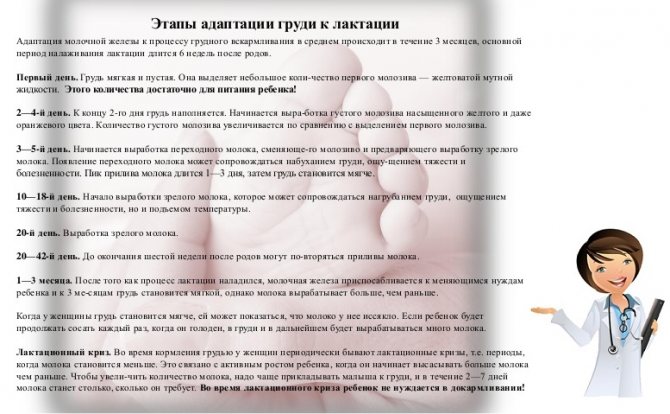03/30/2018 Category: LactationAuthor: Anastasia Isakova
It is well known that breast milk is extremely beneficial, especially in the first year of a child’s life. There is currently no product that completely replicates the composition of breast milk. A woman’s inner attitude and desire to breastfeed will allow her to raise a healthy, energetic child. What components in breast milk make it so valuable and irreplaceable? Is the composition of milk intended for a newborn and a two-year-old baby the same? Let's figure it out.
- Preparing for lactation
Video: physiology of breastfeeding - Video: preparing for lactation during pregnancy
- Types of breast milk
Colostrum
Table: qualitative and functional characteristics of colostrum
- Table: composition of colostrum
- Video: colostrum - first milk
- Video: when milk appears
- Table: features of mature milk in comparison with transitional milk
- Table: composition of breast milk and the functions of its main components
- Table: changes in the composition of mature milk as the child grows
What is mature lactation
The stable production of breast milk by a nursing mother in equal quantities without interruption is called mature lactation. The period of breastfeeding is not so simple. In order for there to be enough milk, corresponding changes occur in the woman’s body. Preparation for milk production occurs in the last trimester of pregnancy. Immediately after the baby is born, there may be no milk at all or in small quantities. Only with regular feeding is mature lactation established.
Phases of lactation
Milk production in the female body goes through several phases before it stabilizes:
- Preparation - in the third trimester, a pregnant woman’s body begins to produce special hormones that “force” the mammary glands to prepare for feeding the baby. The milk ducts become wider. The number of lactocytes increases, which stimulate production. A few weeks before the baby is born, colostrum appears in the mammary glands.
- Formation, in turn, goes through the same stages: launch, development, maturity, addiction. A signal for increased milk production is the release of the “baby spot” during labor. At first, the milk arrives quite noticeably, in specific rushes. It begins to be intensively produced by the female body approximately 40 hours after birth. Colostrum comes first, then milk, which will be produced as long as the baby needs it. Gradually, the female body gets used to its position and responds to the child’s demand to feed him. If the baby draws all the milk from the breast, it is produced more intensively and its quantity gradually increases.
- Maturity - after three months after birth, the maturity phase of lactation is established. The body of a nursing woman adapts to the needs of the child.
Some women in the mature stage experience lactation crises - when the amount of milk decreases. In this case, many mothers supplement their children with formula. Experts do not recommend rushing to switch to artificial feeding. Lactation will be restored if you know what to do.
Stages of lactation
In the process of preparing a woman’s body for lactation and in the actual process of breastfeeding a baby, right up to its completion, a woman’s hormonal background goes through several stages. Two main hormones play a key role:
- prolactin – “motherhood hormone”,
- Oxytocin is the “love hormone.”
Let's consider the stages of the process of milk formation in the cells of the mammary gland - lactogenesis
:
L
I .
Preparation for lactation. During pregnancy, under the influence of estrogens, progesterone and prolactin, the structure of the mammary gland changes: during this stage, estrogen induces the growth of ducts, progesterone induces their branching, and under the influence of prolactin, the lobes and alveoli of the mammary gland develop, lactocytes - cells, increase in size, produce milk - and about 12 weeks before giving birth, they begin to produce colostrum (in small quantities due to high progesterone levels).
LII. Formation of lactation
– this stage lasts from the moment of birth to 3 months and consists of several stages:
II.1. – Start of lactation
- this stage begins immediately after the birth of the child and the separation of the placenta, when the child is first applied to the breast. If part of the placenta remains in the uterus, this can retain progesterone in the body and delay the onset of this stage. Normally, the level of progesterone begins to fall, and oxytocin begins to increase sharply [1], promoting rapid contraction of the uterus and the effective release of colostrum, which begins to be actively produced during this period.
II.2. - "The Arrival of Milk"
- occurs 30-40 hours after birth, when colostrum changes its composition, turning into transitional milk, and its quantity increases sharply.
At this stage, lactation is completely controlled by the woman’s endocrine system, and milk comes in even if she does not breastfeed. It is at this time that it is necessary to put the baby to the breast as often as possible
prolactin receptors
in the breast tissue (cells that are sensitive to an increase in this hormone and cause the breasts to produce more milk), the number of which subsequently remains unchanged (De Carvalho, 1983).
II.3. – Transition to mature milk.
At this stage, colostrum gradually turns into mature milk under the control of prolactin. For more information about how colostrum differs from milk, read the article “Changes in the composition of milk.”

II.4. –
In parallel with the previous stage, there is
a process of “adaptation”
of the mother’s body (namely, the mammary glands and pituitary gland) to feeding this particular baby - and it lasts for about 3-6 weeks.
The level of prolactin at this time continues to decline steadily, since it has completed the bulk of the work on starting and adjusting lactation - and this lasts for about 3 months. Thus, lactation gradually shifts from being completely endocrine controlled
to the so-called
autocrine control
- when the amount of milk depends not so much on the level of prolactin in the blood, but on the amount of milk sucked (or expressed) by the child.
LIII
.
_ Mature lactation – lasts from 3 months until lactation ends.
Occurs under completely autocrine control, the mother-child system works harmoniously according to the principle “how much milk leaves the breast, so much comes in”
, or
“supply and demand”
. During this period, the level of prolactin gradually reaches a state slightly higher than pre-pregnancy, undergoing only daily fluctuations (at night it is always higher) and temporarily increasing in response to more active sucking of the baby (if there are a lot of prolactin receptors in the chest, then it reacts to such increases very productive). During this period, oxytocin is actively involved in the feeding process, causing the myoepithelium of the alveoli to push milk into the milk ducts and to the nipple (oxytocin reflex).
At this stage, periodically (usually around 3, 6, 9, 12, etc. months) so-called lactation crises, or growth spurts of the child, may occur, when
it
suddenly begins to seem to you that there is not enough milk, the breasts become soft, the baby constantly asks for the breast, as in the first weeks of life, practically “hanging” on it. Don’t worry, and especially don’t supplement your baby with formula only on the basis of these symptoms - this is simply how the baby gives a signal to the breast: “I’ve grown up, I already need more milk than before!” And since the “supply-demand” system has already been established, in response to constant sucking stimulation, the breast “responds” with an increase in milk production within 3-7 days.
LIV
.
Involution (physiologically occurs on average at about 2.5-4.2 years) is the process of curtailing lactation. The involution of lactation can be divided into two stages:
active stage
– a decrease in the amount of milk produced, when the level of prolactin decreases sharply, milk production is reduced, and the destruction of the cells that produce it begins. The composition of milk at this time is similar to the composition of colostrum: it contains many anti-infective factors (macrophages, phagocytes, leukocytes and immunoglobulins) - and this absolutely meets the needs of an older baby. A sign of the mammary gland entering the stage of involution of lactation is the lack of fullness of the breast during long breaks between feedings. If you wean your baby from the breast (that is, completely stop feeding) after this stage, your mammary gland will not give you any negative consequences in the form of stagnation, thickening, mastitis and hormonal imbalances, which are practically guaranteed if weaned before this period (more about weaning in a separate article)
How to recognize mature lactation?
You can understand that mature lactation has begun by focusing on the following signs:
- There is a feeling of lightness in the chest and discomfort disappears.
- Immediately before feeding the baby, the woman thinks that there is not enough milk.
- When milk arrives, pain is no longer felt.
- Softness of the mammary glands is observed, heaviness disappears.
It is important to know that the amount of milk produced does not depend on hormonal changes in a woman’s body, but on how well the baby eats. The more milk he draws out, the more intensively and in greater quantities it is produced.
Hypogalactia
Inability to lactate or produce milk in small quantities is called hypogalactia. Radical disturbance of lactation or its absence is observed in no more than 10% of the total number of women giving birth. It can be early or late, acquired or as a genetic disorder. If acquired, it develops for the following reasons:
- Surgery followed by treatment of a serious illness.
- Psychological barrier after childbirth.
- It was not possible to put the baby to the breast after he was born.
- Various complications during childbirth.
- Nervous tension or depression after childbirth.
- Chronic diseases of the mother.
- Milk stagnation or cracked nipples.
- Failure to adhere to the infant's feeding schedule.
- Baby has colic.
Congenital inability to breastfeed is very rare, but acquired hypogalactia, when the amount of milk decreases at the wrong time, is much more common.
Stages of lactation
With the onset of pregnancy, changes begin in the female mammary gland. The expectant mother may notice that her breasts increase in volume, their shape changes, and the nipples become pigmented and more sensitive. This is how the mammary gland prepares to provide the newborn with nutrition.
The entire lactation period in women is divided into stages:
- First. It begins shortly before birth and lasts several days after the birth of the child. During this period, the mammary glands produce colostrum, a nutritious, high-calorie substance for the newborn. The baby is nourished with just a few drops of colostrum. The yellowish liquid contains immunoglobulins. Therefore, it is so important to put the baby to the breast immediately after birth and actively feed him in the first days. Colostrum takes part in the formation of immunity and stabilizes the intestinal microflora.
- Second. It begins 3-5 days after the baby is born. The period for the arrival of transitional milk differs for each woman, but usually does not exceed 7 days. Unlike colostrum, this milk contains a lot of fats and sugars, and the amount of protein decreases. A characteristic sign of the beginning of the second stage of lactation is breast engorgement. The breasts become dense, women feel a tingling sensation in them, and milk flows out of the nipple in a stream.
- Third. It begins 2-6 weeks after birth and continues until the end of breastfeeding. During this period, a woman produces mature milk, which is why lactation is also called mature. A characteristic feature is the production of milk on demand. The flow begins in response to the baby's sucking movements, so the breast remains soft between feedings. With mature lactation, the likelihood of lactostasis and mastitis decreases. This milk contains more carbohydrates, which ensure intestinal function and promote the proper absorption of iron and calcium. Ripe milk has a thinner consistency. It differs in color for different women, it can be yellowish or with a blue tint.

Formation of lactation
To speed up the maturity phase of lactation, follow these rules:
- Don't starve or overeat.
- Eat rationally.
- Try to avoid stressful situations, perform relaxing techniques to relieve nervous tension.
- Moderate physical activity.
- Avoid overtiring.
- Go to your doctor and ask about foods that improve lactation. Is it worth consuming them or can you do without?
- Milk production is directly related to the baby's needs. In order to have enough milk, it is necessary to feed on demand and generally put it to the breast more often in the first stages of lactation.
If the amount of milk seems to the mother to be insufficient for the baby, then its production can be improved with the help of special medications only with the permission of the doctor.
How to help lactation establish
It is a rare mother who does not encounter problems at the stage of developing mature lactation. The most common is a lactation crisis; it occurs when a child makes big leaps in development, he needs more food, and the nursing mother’s body has not yet had time to adapt to the new conditions of milk production.
It is a mistake to believe that there is less of it - there is simply no more of it. During this period, the baby is capricious, asks for the breast more often and sucks longer. You should not give up breastfeeding in favor of formula milk; a few days will pass and the process will improve - the mother’s body needs a little time to adjust to the baby’s increased food needs.
To help lactation establish, a nursing mother must follow a few simple rules:
- Provide the child with physical contact as often as possible; it not only serves as a means of calming the baby, but also stimulates a powerful release of hormones responsible for lactation.
- Provide the baby with unrestricted access to the breast and feed him on demand. The most important feedings are at night, when the concentration of lactation hormones is maximum. By offering the breast to the baby during these hours, the mother will speed up the process of developing mature lactation.
- Teach your child to grasp the breast correctly - not only the nipple, but also the areola, then the sucking process will be more effective.
- Do not wean your baby off the breast until he lets go; if he lets go of one, immediately offer the second one.
How to strain milk correctly?
In order for milk to be produced consistently, at the beginning of the lactation period it is important to express it correctly:
- Put your baby to your breast more often.
- Before feeding, take a warm shower, directing the stream of water towards your breasts.
- If your baby can't get all the milk out, express. To do this, take one breast with both hands and massage clockwise, intensely squeeze so that the milk flows out. Express until it stops coming out.
- If your milk is stagnant, you can apply cabbage leaves or honey cakes to your breasts (mix wheat flour and honey, make circles and place on the lump in the breast).
Experts disagree on whether it is possible to ask a husband to suck milk if stagnation occurs or to improve lactation. You can try, but you don’t always get the expected result. This is due to the structural features of the jaws in adults. Babies are better suited for this and it is better to put them to the breast more often at the beginning of lactation, then there will be enough milk and the mature phase of milk production will begin faster.











